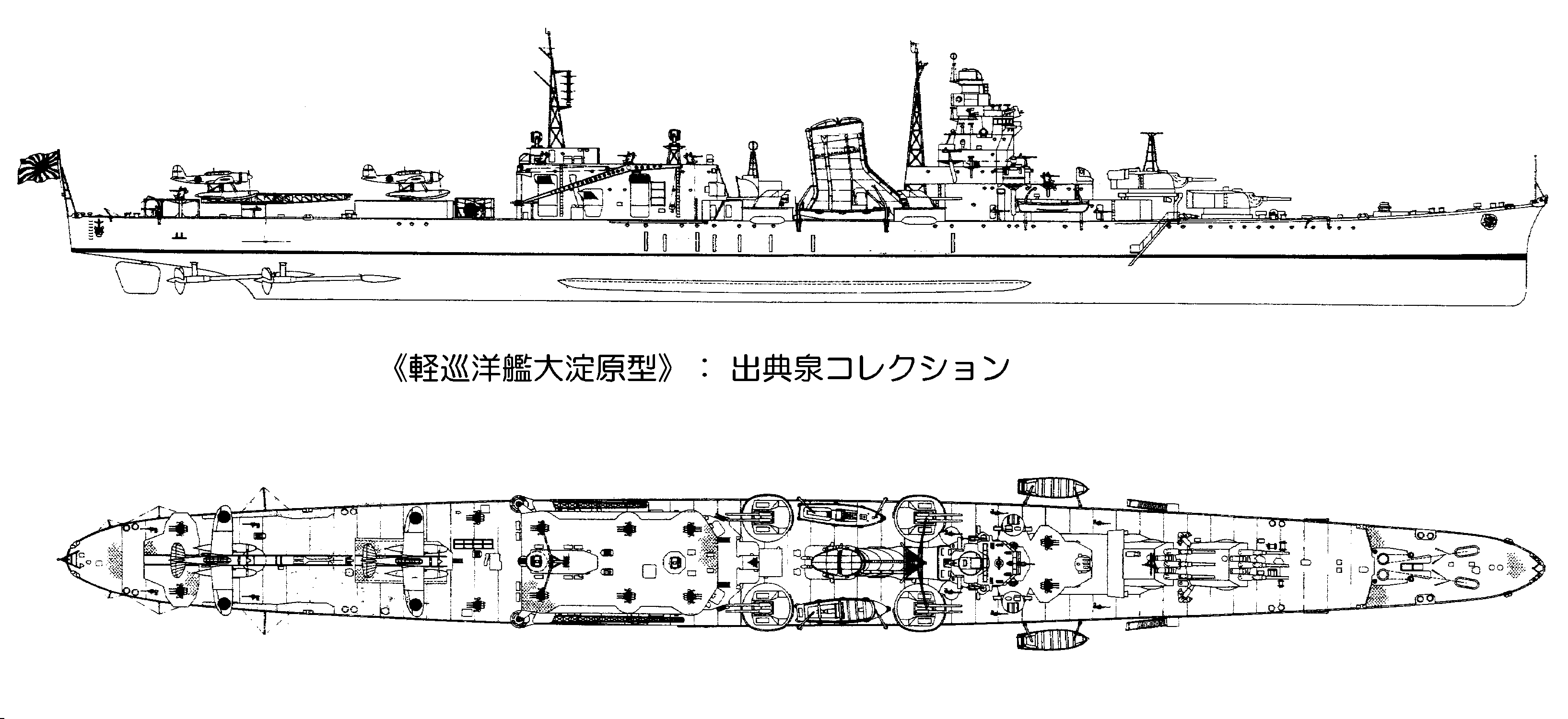- Yes
- No

Classification: Light cruiser Class: Second class cruiser
Ship number: Ship No. 136
Groundbreaking: 1941 Completion: Completed in 1943
Type: Oyodo type Ship number: 1st ship
Ship name: Oyodo, first generation Oyodo
Origin: Place name derived from the Oyodo River that flows through Miyazaki Prefecture. This is not the Yodogawa River in Kansai.
background
Before the start of the Pacific War, the Navy’s plan for war against the United States was for submarine forces to attack the enemy’s main fleet by gradually depleting it. However, it was difficult for submarines to engage enemy fleets alone in the vast Pacific Ocean. Therefore, it was planned to build a reconnaissance cruiser equipped with a new high-speed surface reconnaissance aircraft (Shiun) and capable of conducting forced reconnaissance on the front lines as the flagship of the submarine force.
Because emphasis was placed on the aircraft’s transport ability, it was not equipped with a main gun at the rear, but was instead equipped with a hangar for high-speed surface reconnaissance aircraft and a large ejection device.
history
Completed on February 28, 1943. However, due to the changing nature of the war, she did not serve as the flagship of the submarine squadron, but was instead assigned to transport missions. Due to the poor harvest of the Shiun, the Oyodo was unable to utilize its onboard facilities, and was a light cruiser with poor attack power despite its size, making it difficult to use.
Oyodo was given the task of being the flagship of the combined fleet, which is unusual for a light cruiser.The situation in the war was getting tough, and she couldn’t afford to leave a powerful ship like a battleship alone in the flagship role. Because it was necessary. Taking note of Oyodo’s high communication capabilities, she renovated it to accommodate the combined fleet headquarters, which was an order of magnitude larger than the submarine squadron headquarters, and her large hangar was converted into a headquarters area.
Her flagship mission was also relatively short (less than half a year) as the combined fleet headquarters moved ashore, and Oyodo participated in the Battle of Leyte Gulf, Operation Rei-go, and Operation Kita-go as a light cruiser.
During the Battle of Leyte Gulf, she belonged to the Ozawa fleet, and after her fleet’s flagship, Zuikaku, was hit, she took over her duties as the flagship, taking advantage of her excellent communication skills.
Originally, Oyodo was supposed to be the flagship of Ozawa’s fleet, but Director Ozawa chose Zuikaku as her flagship. The prevailing theory is that this choice caused a discrepancy in communication with the Kurita fleet and other forces, which was the main reason for the crushing defeat of the Japanese army.

During Operation Ceremony, the ship was hit by two bombs, one of which flew into the engine room, but the fuse was disconnected mid-air and the ship did not explode, allowing the ship to escape.
In Operation Hokugo, they succeeded in transporting valuable supplies to the mainland while maintaining sea and air supremacy (at this time, the headquarters facility, which was no longer needed, was renovated again, and the supplies were moved to a state similar to the former hangar). packed).
Although she survived both naval battles almost unscathed and was famous among the Navy for her strength, after Operation Kita, it became difficult to secure enough fuel to operate properly, and she was downgraded to a training ship, her final death in July 1945. On the 28th, she was bombed at Etajima (present-day Etajima City) and capsized and landed on the bottom. On that day, she had been commissioned for exactly two years and five months.
In 1947, two years after Gingza, the ship was refloated, and then towed to her hometown of Kure Naval Arsenal, which had already changed its name to Harima Shipbuilding Kure Works, and was dismantled.
In 1947, two years after Gingza, the ship was refloated, and then towed to her hometown of Kure Naval Arsenal, which had already changed its name to Harima Shipbuilding Kure Works, and was dismantled.
About armament:
Main gun: 2 x 6 60 caliber 15.5cm triple guns
4 Type 98 10cm twin high-angle guns
25mm machine guns: 12 triple mounts, 11 single mounts
others:
1 No. 21 electric probe
2 No. 22 electric probes
1 type zero hydrophone
1 set of Type 93 type 3 probe
underwater traffic light
Technical components:
Crew: 782 people
Standard displacement: 8,168t
Fully loaded displacement: 11,433.373t
Maximum length: 16.60m
Maximum width: 38.9m
Average draft in trial condition: 10.60m
Main boiler: 6 main boilers (with air preheater)
Main engine: 4 Kanmoto type turbines
Power: 110,430shp
Speed: 35.199 knots
Aircraft: 2 seaplanes

sauce:
https://仮想艦隊.jp/cms/blog1.php?itemid=9
http://www.combinedfleet.com/oyodo_t.htm
https://twitter.com/Katubusi_Douhu/status/1713218489048330313







